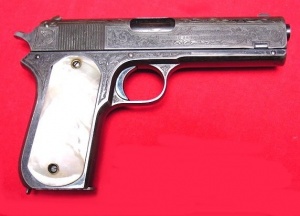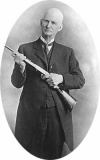Colt Model 1903 Pocket Hammer
| Colt Model 1903 Pocket Hammer | |
|---|---|

| |
|
| |
| Type | Service Pistol |
| Land of Origin | USA |
| Specifications | |
| Length | 197 mm |
| Barrel length | 114 mm |
| Weight | 0.89 kg (unloaded) |
| Cartridge | .38 ACP |
| Action | single action, short recoil |
|
| |
| Feed | 7 round box magazine |
| Sights | iron sights |
| Service History | |
| Used by | United States (very limited use) Philippine Constabulary |
| Wars | Mexican Revolution (?) |
| Production History | |
| Designer | John Browning |
| Manufacturer | Colt Patent Firearms Manufacturing Company of Hartford, Connecticut |
| Produced | 1903 - 1927 |
| No. Built | 29,237 |
Contents |
[edit] Background
At a glance, this pistol is visually more similar to the later Colt 1911 than to the Colt 1902 Sporting Model from which it evolved. However, a cursory inspection will show many differences to the Model 1911: the lack of any safety, as well as the lack of a slide lock, the magazine release is at the bottom of the grip rather than a button on the side, and a wedge retaining the slide. The locking system uses two links vs. the single link of the later M1911. The two links (one near the muzzle, the other under the chamber) unlocked the barrel in a motion identical to that of a parallel ruler. The drawback to this design was the need for a cross-wedge in the slide near the muzzle, for assembly and dis-assembly. This design aspect limited the strength of the cartridge that could be used.

If the slide cracks or the wedge comes loose, the slide can exit the frame to the rear, injuring the shooter.
It was chambered for .38 ACP, which is stamped on the slide as "Calibre 38 rimless smokeless". The .38 ACP was a slightly less powerful cartridge than the 9x19mm Parabellum and it is now considered obsolete as there are no new firearms currently being chambered in .38 ACP. While using a locked breech, the pistol's locking design was not very strong, and was superseded in 1929 by an M1911-pattern pistol chambered in .38 Super.
Initially popular, the sales of the .38 ACP models dropped off with the introduction of the M-1905 in .45, and then the M-1911 caused sales of the .38 to pretty much die off. Colt listed it in their annual catalog until existing parts were used up, sometime in the early 1920s. [1]
Production of the Model 1903 Pocket Hammer Model, basically just a short barreled 1902 Sporting Model, began in earnest in 1904 (only one hundred pistols seeing production in 1903) with production varying from about 1,200 to 2,300 each year until 1917 when production curtailed sharply due to World War I. Up to late 1907, rounded stub hammers were used, but Colt, with the interest of the military and apparently the public now set on low profile spur hammers (due to that requirement on the Model 1907 US test pistols, these being modified Model 1905's with grip safeties), started phasing in low profile spur hammers on all their exposed hammer automatics that they were continuing in production: the 1903 Pocket Hammer Model, the 1902 Military Model, and the 1905 Model .45 ACP. Therefore the rounded hammer Colt 1903 pocket hammers can help date those pistols at a glance to 1903-1907.
Unlike the Sporting Model from which it was derived, and the 1902 Military Model, which had milled slide grooves and checkered slides respectively, the 1903 Pocket Hammer featured slide grooves at the rear of the slide. The first pistols featured the milled pattern similar to the 1902 Sporting Models, but Colt transitioned to rear cut slides around the spring of 1905, apparently for all their automatics. This would indicate that only about 1,700 or so 1903 Pocket Hammers had the rear milled slides, making them the earliest and hardest to find of the type.
Serial numbers of the 1903 pocket hammers started at 19999 in 1903 and went backward (why?) to 16000 into 1906. After that, serials resumed at 20000 and went up to 47227 ending in 1927 when production discontinued. An approximate total of 29,237 were produced which just about equaled the production of the Colt 1900 and 1902 .38 automatics. Prior to World War I, the pistol filled a niche by providing a relatively more powerful cartridge in a lighter and smaller pistol. However, the Colt 1903/08 Pocket Hammerless in .380 ACP (a lower power cartridge to the .38 ACP, but suitable to smaller simple blowback pistols) appeared in 1909. The .380 Pocket Hammerless overwhelmed the pocket hammer model's sales but the 1903 persisted, possibly because the .38 ACP was still a more powerful cartridge than the .380 ACP. However, World War I clearly slowed production and after production surged to 3200 in 1920 (probably to fill dealer back orders built up during the war), sales became very slow and the 1903 pocket hammer faded out of use, while the smaller 1903 .380 and .32 ACP pocket hammerless pistols thrived.
Only a scant handful of 1903 Pocket Hammer's were used by the military, and then only as secondary arms purchased not pursuant to contract. However, the Model did see significant sales in Mexico prior to and possibly during the chaos of the Mexican Revolution (1910-1920)so many of these found their way into military and para-military hands. Additionally, some were purchased for the Philippine Constabulary in the 1920s.
[edit] Resources

This article or section is missing resources, such as diagrams or manual links, and could use more input to fill in the missing bits. You (yes, you!) can help Gunsopedia provide more comprehensive information to our users by using your own knowledge to add to it.
[edit] References
- ↑ The .38 Super Automatic +P: A Brief History by Mark Freburg, Outdoor Network, 2006
- Goddard, William, The Government Models, Andrew Mobray Inc, 1988,1998, ISBN:0-917218-24-8
[edit] External links
| This article is part of a series on the works of John Moses Browning | ||
|---|---|---|
| Semi-automatic pistols | FN M1900 · Colt M1900 · Colt M1902 · FN Model 1903 · M1903 Pocket Hammer · M1903 Pocket Hammerless · M1908 Vest Pocket · FN Model 1910 · M1911 · Colt Woodsman · Baby Browning · Hi-Power |  |
| Rifles | Winchester Model 1885 · Winchester Model 1886 · Winchester 1892 · Winchester Model 1894 · Winchester Model 1895 · Remington Model 8 · Remington Model 24 · FN Trombone | |
| Shotguns | Winchester Model 1887 · Winchester Model 1897 · Browning Auto-5/Remington Model 11 · Remington Model 17 · Savage Model 520 · Browning Superposed · Ithaca 37 | |
| Machine guns | Colt-Browning M1895 · Browning M1917 · Browning Automatic Rifle · Browning M1919 · M2 Machine Gun | |
| Cartridges | .25 ACP · .32 ACP · .38 ACP · .380 ACP · .45 ACP · .50 BMG | |
| This article is part of a series on .38 caliber goodies | |
|---|---|
| Cartridges | .38 Long Colt (1875) | .38 S&W (1877) | .38 ACP (1900) | .38 Special (1902) | .380 ACP (1908) | .38/200 (1922) | .38 Super (1927) |
| Revolvers | M1899 Revolver | Smith & Wesson M&P/Victory | Webley Mk IV | Enfield No. 2 Mk I | Colt Detective Special |
| Pistols | Colt M1900 | Colt M1902 | Colt Model 1903 Pocket Hammer | Colt M1908 Pocket Hammerless | Browning M1910 | Walther PPK | HK 4 |